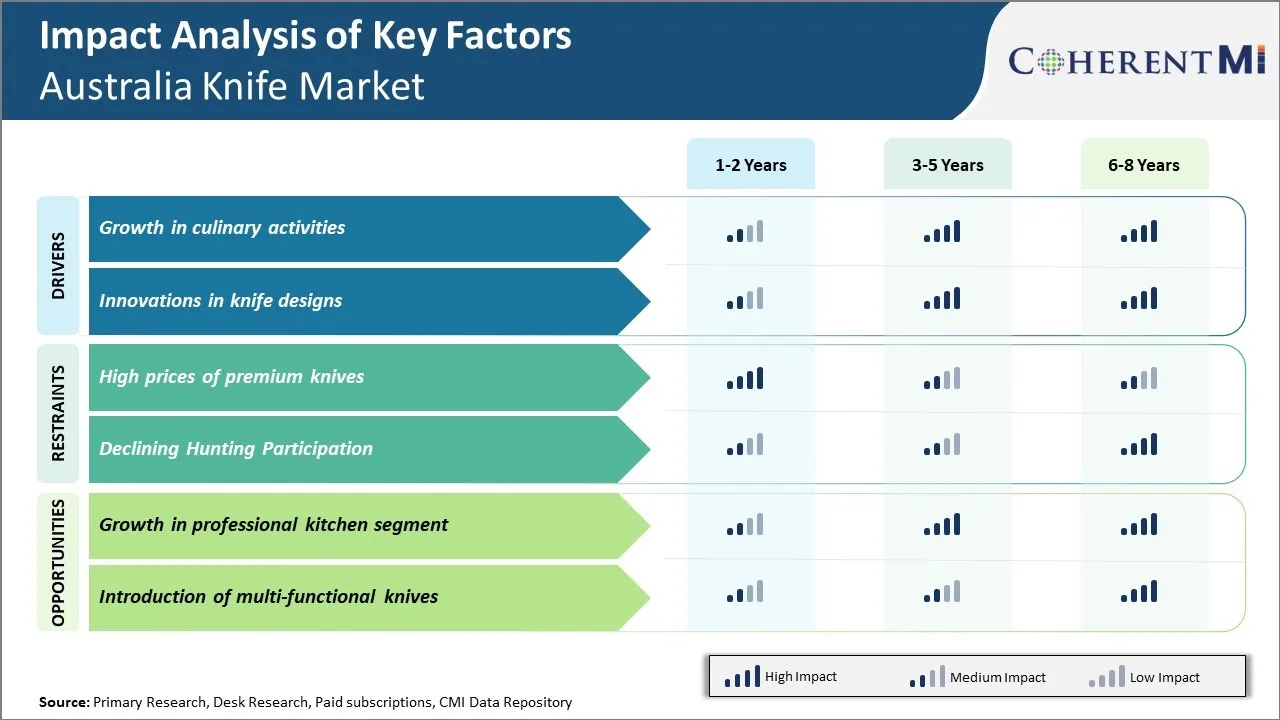Australia Knife Market Trends
Market Driver - Growth in Culinary Activities
The Australians have always had a strong food culture and over the years, culinary activities have become quite popular in the country. Cooking shows on television and online videos have generated a lot of enthusiasm among people of all age groups to experiment more in kitchen and try new recipes. This has led to higher demand for better quality cooking knives that can help in cutting, chopping and preparing wide variety of ingredients easily and efficiently.
Most Australian homes now have aspiring chefs who love spending time in kitchen and create delicious meals. This has encouraged people to upgrade their basic utensils and purchase knives that make food preparation safe, convenient and fun. Rather than just basic knives for chopping vegetables, Australians now want knives suited for precise tasks like filleting fish, slicing meat paper thin, dicing onions and mincing garlic. Specialty knives made of high-quality steel especially attract home chefs.
Food blogging has become a major trend in Australia which brings attention to unique cooking styles and ingredients. Many Australians travel within the country and get influenced by regional cuisines. They like recreating these dishes in their own kitchens which requires having right tools. Furthermore, culinary schools and short courses on topics like baking, grilling etc are attracting large number of enthusiasts. All these aspiring foodies recognize the importance of right knives for smoothly gliding through preparations. Apart from home use, restaurants and cafes are also expanding their menus and introducing global flavors. This has increased their demand for professional grade knives that can withstand high volume prepping and last longer. Certain regions and communities in Australia have also gained popularity for their food festivals where artisanal processing involves ethnic style bread making, curing meats, filleting fish - activities that require specialist knives.
Market Driver - Innovations in Knife Designs
Knife manufacturing companies have picked up on the growing interest in cooking among Australians and are frequently introducing new designs that offer enhanced features. While basic styles fulfill utilitarian needs, home chef enthusiasts seek knives that perform specific tasks meticulously and also look attractive on kitchen counter. Innovation allows addressing these aspirations.
Full tang construction is now common where the internal bolster is extended through the entire handle for better balance and control during intense use. Non-slip ergonomic handles made of diverse materials like wood, plastic and Santoprene provide firmer grips. Blade materials have undergone massive evolution as well - high carbon stainless steel and ceramics are replacing softer steel and providing sharper, durable and rust-resistant edges.
Knife makers keep the changing regional Australian cuisine trends in mind. For instance, they have designed fillet knives targeted at seafood prevalent coasts or cleavers for areas influenced by Asian cooking styles relying on chopping. Santoku knives have become quite popular fulfilling the need for versatile all-purpose use. Specialty knives keep emerging for niche applications like bird and joint weapons. Artisanal knife manufacturers offer visually appealing designs blending tradition and innovation. For example, hand-hammered Damascus steel blades infused with unique patterns and stabilized wood handles inlaid with precious stones enthral aesthetics driven home chefs. Even mass market brands strive to make basic utilitarian knives appear trendy through varied colours, ergonomic contours and marketing.

Market Challenges: High prices of premium knives
One of the key challenges currently being faced by the Australia knife market is the high prices of premium quality knives. While high-end premium knives offer superior craftsmanship, durability and performance compared to cheaper knives, their high price point puts them out of reach of average consumers and professional chefs. Premium hunting, kitchen and pocket knives from renowned international brands can easily cost between $200 to $1000 or more per piece in Australia. This high pricing is discouraging new customers from experimenting with premium knives and encouraging the use of cheaper substitutes. It also prevents smaller restaurants and home chefs from fully equipping their kitchens with high-quality cutlery. The pricing gap between affordable basic knives and expensive premium brands needs to be bridged either through new local brands offering competitive mid-range options or premium brands exploring affordable product lines without compromising much on quality. Otherwise, these high prices will continue restricting the overall growth potential of the Australia knife market.
Market Opportunities: Growth in professional kitchen segment
One significant opportunity for the Australia knife market lies in catering to the growing professional kitchen segment. With the booming foodservice and hospitality industry in Australia, the number of restaurants, cafes, hotels and commercial kitchens has been increasing steadily over the past few years. This has led to a surge in the demand for high-quality knives that can withstand the rigors of daily commercial use. While the basic needs of these commercial kitchens are already being met, there exists scope for premium brands to tap into this segment by developing blade shapes, styles and features customized for professional sharpening and durability. New product innovations focused around safety, ergonomics and maintenance could attract more professional establishments. In addition, targeted marketing activities, promotion offers and tie-ups with culinary schools and institutions would help boost awareness and trial among professional chefs and kitchen staff. Catering to the discerning needs of commercial food businesses therefore provides an avenue for growth to Australia's knife manufacturing industry.